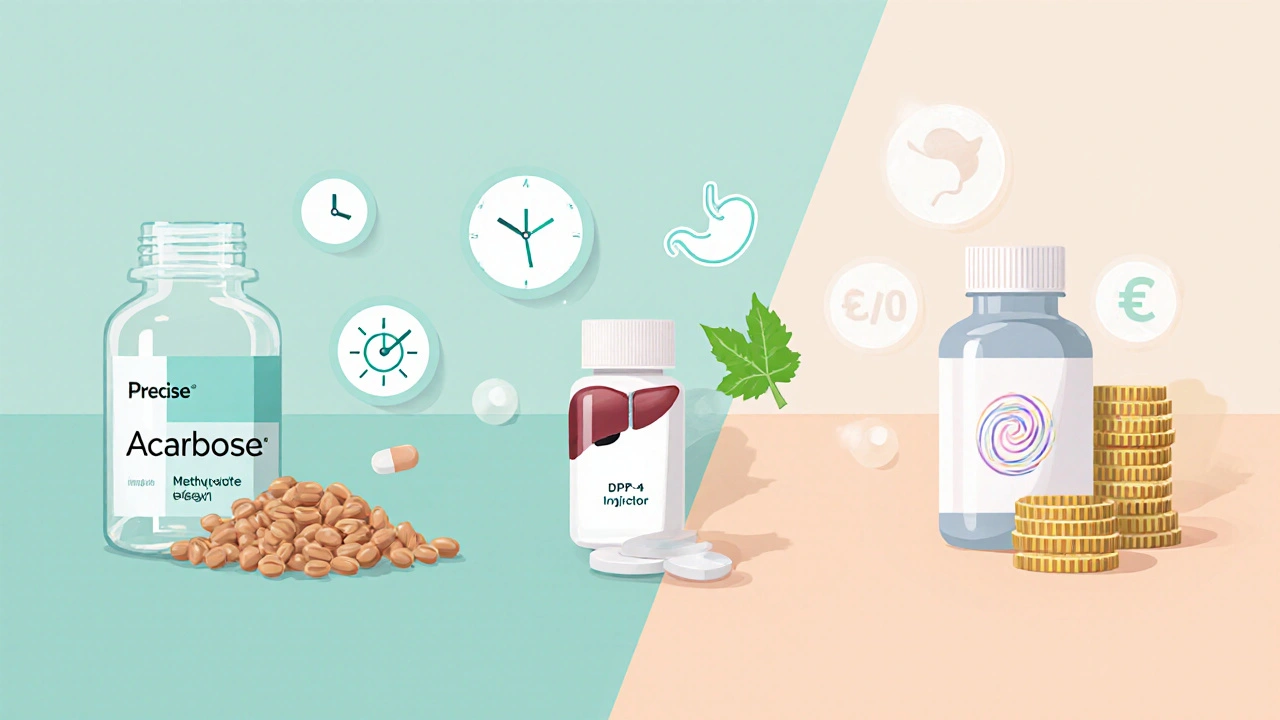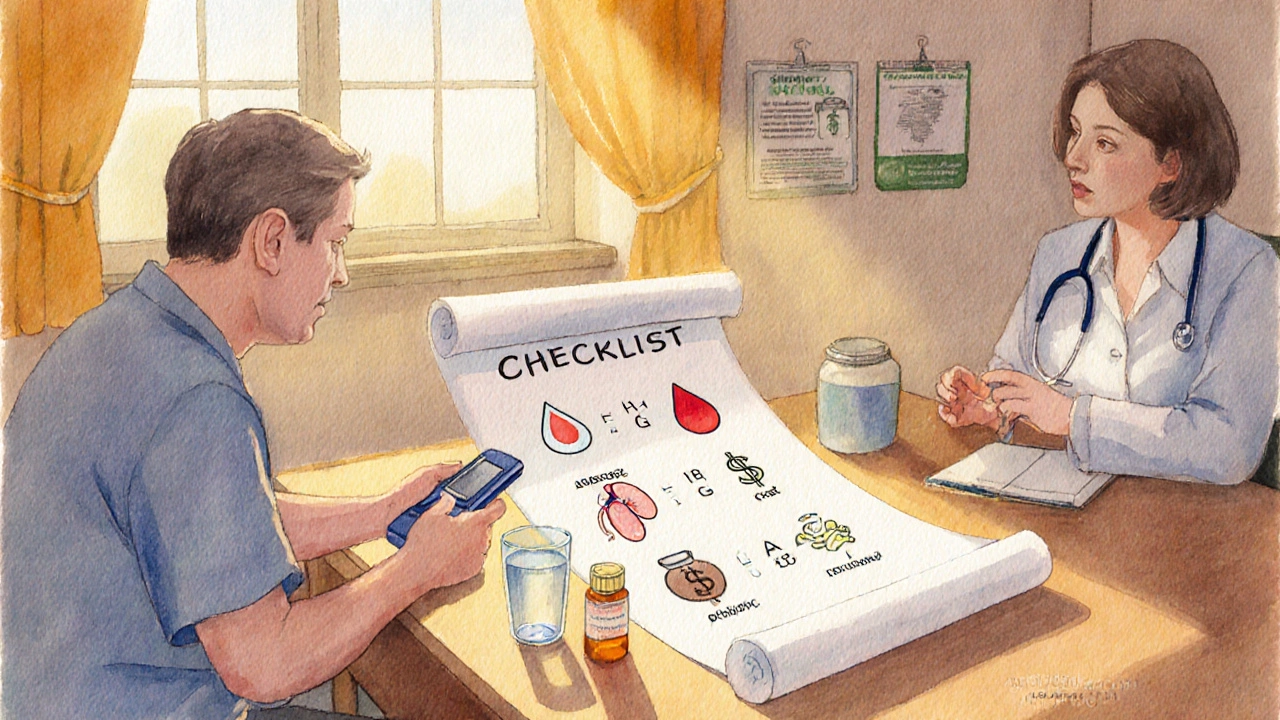Precose (Acarbose) vs Alternatives Comparison Tool
Recommended Medication Based on Your Inputs
Detailed Comparison
Precose (Acarbose)
- Efficacy: Reduces post-meal glucose spikes by 0.5-0.8% HbA1c
- Side Effects: Flatulence, abdominal pain, diarrhea (up to 30%)
- Dosing: 3x daily with meals
- Weight Impact: Weight neutral
- Cost: $75-$100/month
Metformin
- Efficacy: Reduces HbA1c by 1.0-1.5%
- Side Effects: GI upset, metallic taste (up to 25%)
- Dosing: 1-2x daily with meals
- Weight Impact: Weight loss (1-2 kg)
- Cost: $30-$50/month
Miglitol
- Efficacy: Reduces post-meal glucose spikes by 0.5-0.7% HbA1c
- Side Effects: Flatulence, diarrhea (up to 20%)
- Dosing: 3x daily with meals
- Weight Impact: Weight neutral
- Cost: $80-$110/month
DPP-4 Inhibitors (e.g., Sitagliptin)
- Efficacy: Reduces HbA1c by 0.5-0.9%
- Side Effects: Headache, nasopharyngitis (≤10%)
- Dosing: Once daily
- Weight Impact: Weight neutral
- Cost: $200-$250/month
Side Effect Notes
Trying to decide whether Precose (acarbose) is the right pill for your blood‑sugar control can feel like a maze of medical jargon. You want to know if it actually works, how it stacks up against the more popular options, and whether the side‑effects are worth the trade‑off. This guide cuts through the noise, compares the top alternatives point‑by‑point, and gives you a clear checklist to help you pick the best fit for your situation.
What is Precose (Acarbose)?
Precose is a prescription medication that contains the active ingredient acarbose, an alpha‑glucosidase inhibitor. It works by slowing the breakdown of complex carbohydrates in the small intestine, which reduces the post‑meal rise in blood glucose. Approved worldwide for managing type 2 diabetes, it’s usually taken with the first bite of each main meal.
How Acarbose Fits Into the Diabetes Toolkit
The drug belongs to the alpha‑glucosidase inhibitor class, a group that targets enzymes responsible for carbohydrate digestion. By delaying carbohydrate absorption, acarbose primarily tackles postprandial glucose spikes rather than fasting glucose levels. This makes it a useful add‑on when fasting glucose is already well‑controlled but meals still send HbA1c numbers creeping upward.
Key Decision Criteria When Comparing Diabetes Medications
- Glycemic efficacy: How much does the drug lower HbA1c and post‑meal glucose?
- Safety profile: Frequency of gastrointestinal or other adverse events.
- Dosing convenience: Number of pills per day and timing with meals.
- Weight impact: Does the medication cause weight gain, loss, or is weight neutral?
- Cost & insurance coverage: Out‑of‑pocket expense for a typical 30‑day supply.

Popular Alternatives to Precose
Below are the most common drugs clinicians consider alongside acarbose.
Metformin
Metformin is the first‑line oral agent for type 2 diabetes that reduces hepatic glucose production and improves insulin sensitivity. It’s taken once or twice daily with meals and is known for modest weight loss and a low risk of hypoglycaemia.
Miglitol
Miglitol is another alpha‑glucosidase inhibitor that, like acarbose, slows carbohydrate absorption but has a shorter half‑life. It’s typically dosed three times a day with meals.
Voglibose
Voglibose is a newer alpha‑glucosidase inhibitor used mainly in East Asia; its dosing schedule mirrors that of acarbose (three times daily).
DPP‑4 Inhibitors (e.g., Sitagliptin)
These drugs work downstream of the gut, boosting endogenous incretin hormones to improve insulin release after meals. They’re taken once daily and have a very low gastrointestinal side‑effect profile.
Side‑Effect Profile at a Glance
All the drugs above can cause mild nausea or abdominal discomfort, but the frequency and severity differ.
| Attribute | Precose (Acarbose) | Metformin | Miglitol | Voglibose | DPP‑4 Inhibitor |
|---|---|---|---|---|---|
| Primary Mechanism | Alpha‑glucosidase inhibition (delays carb absorption) | Decreases hepatic glucose output, improves insulin sensitivity | Alpha‑glucosidase inhibition (shorter half‑life) | Alpha‑glucosidase inhibition (similar to acarbose) | Inhibits dipeptidyl peptidase‑4, increases incretin levels |
| HbA1c Reduction | 0.5‑0.8% | 1.0‑1.5% | 0.5‑0.7% | 0.5‑0.8% | 0.5‑0.9% |
| Post‑Meal Glucose Control | Strong | Moderate | Strong | Strong | Good |
| Common Side‑Effects | Flatulence, abdominal pain, diarrhea (up to 30%) | GI upset, metallic taste (up to 25%) | Flatulence, diarrhea (up to 20%) | Flatulence, abdominal discomfort (up to 25%) | Headache, nasopharyngitis (≤10%) |
| Weight Impact | Weight neutral | Weight loss (1‑2kg) | Weight neutral | Weight neutral | Weight neutral |
| Dosing Frequency | 3× daily with meals | 1‑2× daily with meals | 3× daily with meals | 3× daily with meals | once daily |
| Typical Cost (US$) | $75‑$100 per month | $30‑$50 per month | $80‑$110 per month | $90‑$115 per month | $200‑$250 per month |
Who Should Consider Precose?
If you already have decent fasting glucose control on metformin but struggle with post‑meal spikes, acarbose can fill the gap without adding weight gain. It’s also a good choice for patients who are contraindicated for metformin (e.g., advanced kidney disease) because acarbose isn’t cleared renally. However, be ready for the tell‑tale GI side‑effects-starting with a half‑tablet and gradually titrating can help.

When Alternatives Might Be a Better Fit
Patients who dislike taking pills three times a day often prefer a once‑daily DPP‑4 inhibitor despite the higher price. Those with a strong aversion to flatulence may lean toward metformin (especially the extended‑release form) because its GI profile is milder and it aids weight loss. Miglitol and voglibose are essentially acarbose cousins; choose them only if you’ve tried acarbose and still need a tweak in dosing schedule.
Practical Checklist Before Switching or Adding Acarbose
- Confirm your latest HbA1c and identify whether post‑prandial glucose is the main problem.
- Review kidney and liver function - acarbose is safe in mild renal impairment but watch for severe disease.
- Discuss cost with your pharmacy; generic acarbose may be cheaper than brand‑name DPP‑4 inhibitors.
- Start with 25mg with the first bite of each meal; increase to 50mg after one week if tolerated.
- Track GI symptoms for two weeks. If diarrhea persists, consider adding a probiotic or switching to another agent.
- Schedule a follow‑up HbA1c test in 3 months to evaluate effectiveness.
Frequently Asked Questions
Can I take acarbose with metformin?
Yes. Combining acarbose with metformin is a common strategy to cover both fasting and post‑meal glucose. Start metformin first, then add a low dose of acarbose and titrate slowly.
What should I do if I experience severe diarrhea?
Reduce the dose to the lowest tolerated amount or pause the medication for a few days. If symptoms don’t improve, discuss switching to an alternative with your doctor.
Is acarbose safe during pregnancy?
Acarbose is classified as Pregnancy Category C. It should only be used if the potential benefit outweighs the risk, and typically only under specialist supervision.
How quickly does acarbose start working?
Because it works in the gut, you’ll notice a reduction in post‑meal glucose spikes within the first few meals. Full HbA1c impact takes 8‑12 weeks.
Do I need to monitor blood glucose more often when starting acarbose?
It’s wise to check glucose before and after meals for the first two weeks to confirm the drug’s effect and to catch any unexpected hypoglycaemia, especially if you’re also on insulin or sulfonylureas.

18 Comments
Jason Oeltjen
People should read the label before poping pills, especially when the side‑effects sound like a gas factory.
Mark Vondrasek
Oh great, another deep‑dive into the labyrinth of diabetes meds – just what we needed, right? You get the sense the pharma industry is secretly running a reality‑show where the prize is better HbA1c numbers, and the contestants are our stomachs, which end up auditioning for the role of a bubbling cauldron. The whole thing feels like a conspiracy where every table entry hides a secret agenda, and the only way out is to become a walking, talking spreadsheet.
Joshua Agabu
The comparison chart is useful if you just want the facts without the fluff.
Lolita Rosa
Honestly, the whole debate feels like a drama played out on a cheap stage, with each drug trying to out‑shine the other, but the audience (us) just wants a simple solution that won’t make us sound like a marching band of flatulence.
Matthew Platts
Hey folks, if you’re scared of the gas side‑effects, start low and give your gut time to adjust – you’ll be surprised how manageable it can be.
Matthew Bates
From a pharmacological perspective, acarbose functions as an alpha‑glucosidase inhibitor, thereby decelerating carbohydrate hydrolysis in the proximal small intestine. This mechanism directly attenuates postprandial glucose excursions, which is reflected in the modest HbA1c reduction of approximately 0.5‑0.8 %. In contrast, metformin exerts its primary effect via inhibition of hepatic gluconeogenesis and enhancement of peripheral insulin sensitivity, thereby achieving a more pronounced HbA1c decline in the range of 1.0‑1.5 %. The dosing frequency of acarbose (three times daily with meals) may be perceived as inconvenient relative to the once‑daily regimen of DPP‑4 inhibitors, yet it offers a weight‑neutral profile akin to the latter. Gastrointestinal adverse events, chiefly flatulence and diarrhoea, occur in up to 30 % of patients receiving acarbose, a rate that exceeds that of metformin’s 25 % incidence of GI upset. Nevertheless, titration strategies-initiating therapy with a 25 mg dose and incrementally escalating-can mitigate tolerability concerns. Economically, acarbose’s monthly cost ($75‑$100) surpasses that of generic metformin ($30‑$50) but remains substantially lower than DPP‑4 inhibitors ($200‑$250). Renal function considerations are pivotal; acarbose is primarily excreted unchanged via the gastrointestinal tract, rendering it suitable for patients with mild to moderate renal impairment, whereas metformin necessitates dose adjustment or contraindication in advanced renal disease. The therapeutic decision matrix should therefore integrate efficacy, safety, patient adherence potential, and financial burden. Ultimately, clinicians may employ acarbose as an adjunct to metformin for patients inadequately controlled on metformin alone, especially when postprandial hyperglycaemia predominates. Continuous patient education regarding dietary carbohydrate content and adherence to dosing schedules remains essential to optimise outcomes. Regular monitoring of HbA1c at three‑month intervals will elucidate the additive benefit of acarbose therapy. In summary, while acarbose is not a first‑line agent, its targeted mechanism renders it valuable in specific clinical scenarios, provided that patients are counselled on expected gastrointestinal side‑effects and cost implications.
Kasey Mynatt
Look, I get that the side‑effects can be a nightmare, but the fact that acarbose is weight‑neutral gives it a dramatic edge over metformin for those of us fighting a bulge. If you’re willing to power through the occasional gas, you’ll thank yourself when those post‑meal spikes finally settle down.
Edwin Pennock
Honestly, the whole thing feels like a witch‑hunt against carbs. If you think the pharma guys are secretly hiding something, you’re probably right, but the data still shows acarbose does what it says on the tin.
John McGuire
💪🏽 Let’s keep the momentum going! Adding a little emoji power to the conversation-if you’re on acarbose, remember to stay hydrated and maybe keep a probiotic handy. You’ve got this!
newsscribbles kunle
My fellow patriots, don’t let the globalist agenda push cheap meds on us. Stand firm, demand transparency, and choose a drug that doesn’t make you feel like a balloon.
Bernard Williams
Hey everyone, just wanted to share that I started acarbose at a low dose and paired it with a low‑glycemic diet. The GI side‑effects were manageable and my post‑meal glucose numbers dropped nicely. Keep an eye on your carbs and stay consistent!
Michelle Morrison
In the grand scheme of pharmaceutical conspiracies, one must ask whether the data presented here is not merely a façade, a veneer meticulously crafted to divert the masses from the true nature of metabolic control. The omission of long‑term safety profiles, the subtle emphasis on cost, all hint at an agenda that seeks to keep us tethered to perpetual consumption.
harold dixon
I appreciate the thorough breakdown; however, I’d be interested in seeing real‑world adherence data for acarbose versus metformin. The three‑times‑daily schedule could be a barrier for many patients.
Darrin Taylor
Sure, the table looks neat, but have you considered the hidden tax of side‑effects? I’m skeptical of any drug that forces you to plan your meals around a pill.
Anthony MEMENTO
While the data is presented in a polished format, it fails to address the pharmacogenomic variability that could influence patient response to acarbose.
aishwarya venu
Just a reminder: anyone starting acarbose should monitor blood sugars more frequently during the first weeks to catch any unexpected dips.
Nicole Koshen
Great summary! I’d add that extended‑release metformin can reduce GI upset, which is useful for patients who can’t tolerate acarbose’s gas.
Ed Norton
Nice overview - keep it coming.